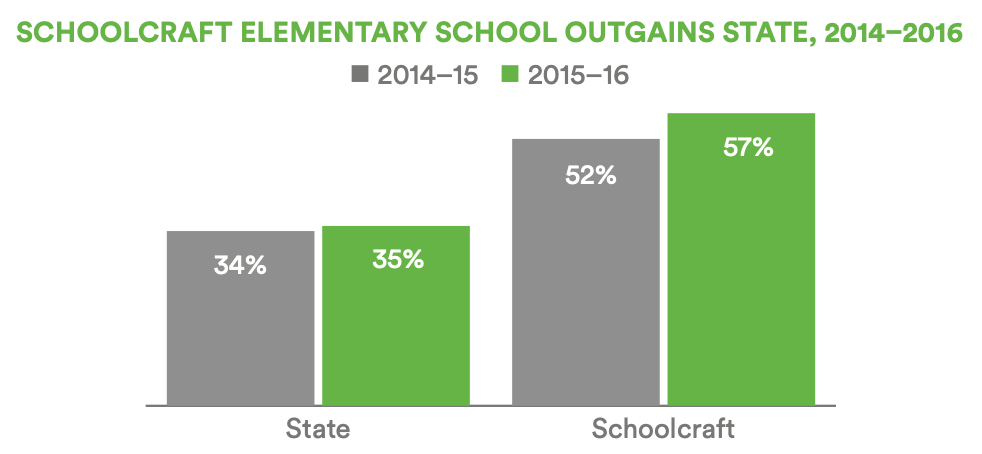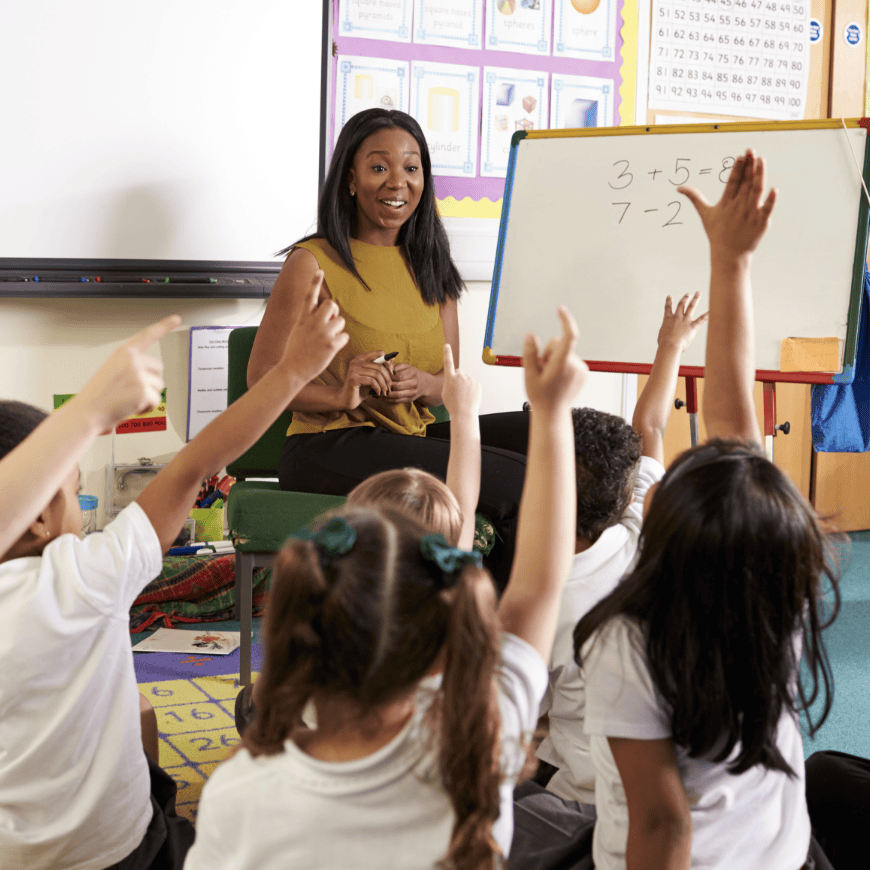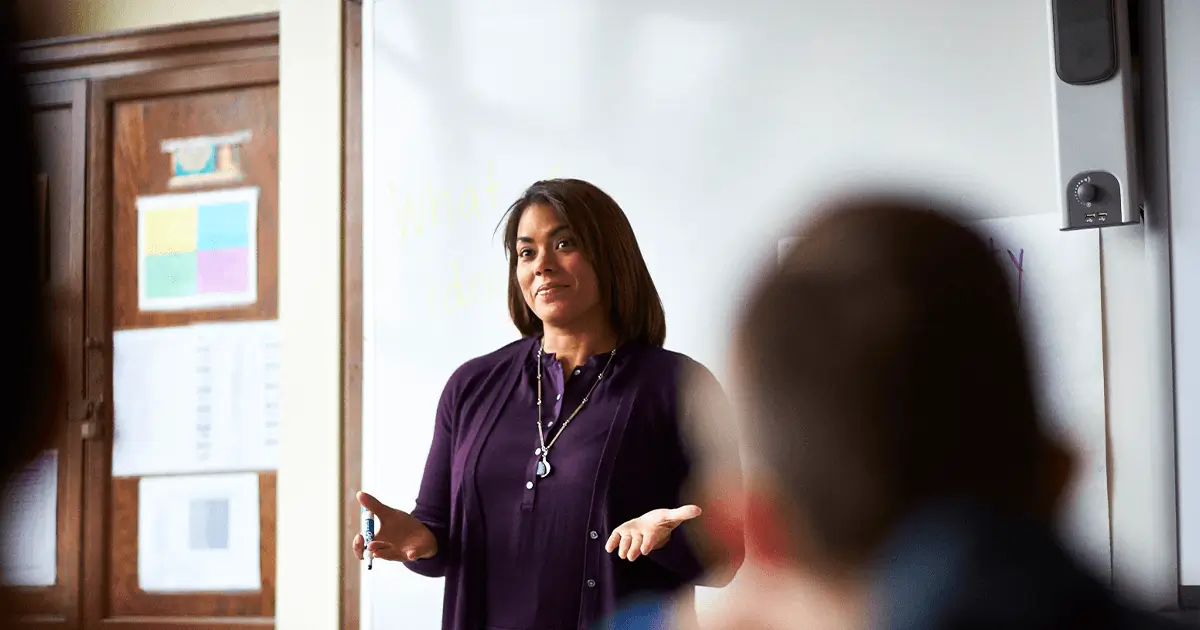Posted in: Aha! Blog > Eureka Math Blog > Student Engagement Data Stories Student Achievement > Schoolcraft Elementary Makes Math Fun While Improving Test Scores by 15 Percent
“Wear” the Eureka Math® curriculum for a while. Customize the lessons for your students. And have fun.
SCHOOL PROFILE
Number of students: 382
Free/Reduced Lunch: 22%
White: 94%
African American: 0.5%
Hispanic: 1%
Asian: 0.2%
That’s the advice from leaders at Michigan’s Schoolcraft Elementary School to first-time Eureka Math implementers. And they should know. In the three years since the larger Schoolcraft Community Schools adopted Eureka Math across Grades K through 12, some elementary students there have jumped from the 68th percentile to the 83rd percentile on state standardized math tests.
Overall, elementary students gained five points on the state’s standardized math test from 2014-15 to 2016-17, from 52 to 57 percent proficiency; the state gained an average of only one point during that same period.

“Let the curriculum and instruction be rigorous, let it be uncomfortable for a while,” says Principal Matt Webster. “Data like ours are a good example of what happens when you teach Eureka Math with fidelity and grow with it. Before you jump in, get to know it first. We’ve said, ‘Let’s wear it for a while before we tailor it.’ It might be uncomfortable, but we have to wear it.”
Schoolcraft Elementary’s approach is paying off in ways far beyond improving test scores. Grade 2 teacher Jenny Stull says students are mastering the topics and finding a newfound love for math.
“It’s amazing how quickly they pick up on new things,” she says. “I just finished Module 4 and had a second-grade student come up to me and say, ‘Oh, I just wanted to show you a few different ways to solve the problem.’ I went on a field trip, and one of my students on the bus was so upset that we were missing math, she wanted me to change my schedule. They’re so excited. They really feel like mathematicians.”
COHERENCE IS KEY
Before Schoolcraft Community Schools adopted Eureka Math in 2014–2015, Stull was one of the architects of the elementary math program as the teacher responsible for cobbling together its Grade 1 math curriculum—an experience, she says, that made her immediately appreciate the coherence of Eureka Math.
"It was very welcome to have a resource that was coherent across all the grades. It felt as though we were all on the same page and working toward a common goal."
— Matt Webster, principal
“I brought in pieces and parts from different places,” she recalls. “So it was very welcome to have a resource that was coherent across all the grades. It felt as though we were all on the same page and working toward a common goal.”
To reach that goal, Schoolcraft Elementary made teacher support a priority. Stull and her colleagues have common planning time, weekly 90-minute professional learning sessions, and regular peer observations. They also attend regional Great Minds Institutes that bring educators together for multiday professional development sessions designed to strengthen implementation of Eureka Math and provide a forum for networking and sharing best practices.
CUSTOMIZING INSTRUCTION
Over the last three years, Stull and her colleagues have had plenty of Eureka moments. One was learning to get away from a near total reliance on whole-group instruction. Now, they tailor lessons to a range of diverse students.
Her students love Sprints, so she always conducts those with all her students. But the class has evolved to where she teaches to the whole group only about a third of the time, which allows for more individualized instruction.
As part of this customization effort, Schoolcraft Elementary is developing “on-ramps and off-ramps” to allow students to grow at their own pace. For example, Webster says the school is considering how to accommodate advanced students who might be ready to jump ahead in the curriculum early.
“For a student who shows mastery of the second-grade standards, how and when do we advance them to a third-grade band of standards, and what will that look like? We’re in the middle of playing with that process. It’s a good challenge to have, but certainly a challenge that’s new to this team,” Webster says.
TRY A “PALOOZA”
Games are another key to Schoolcraft Elementary’s Eureka Math success story. In the early days of implementation, when students were still getting familiar with the curriculum’s vocabulary, models, and other features, Stull created games to introduce new problem-solving strategies. Today, she still uses those games to nail down key concepts and differentiate or customize instruction based on student needs.
“We do things like Tape-Diagram-a-Paloozas, where we have the whole second grade walk around to different stations,” Stull says. “They earn prizes, but at the same time they are working on ‘What is a number bond? How can I use number bonds?’ We are able to differentiate: ‘Oh, you three kids go to that station over there.’ It is wonderful and so much fun. I’ve had paloozas for everything: a Tape-Diagram-a- Palooza, a Number-Bond-a-Palooza, and others.”
STUDENTS TEACHING PARENTS
Eureka Math is an innovative new approach to mathematics instruction. It’s very different from the math instruction most parents experienced, and they can be skeptical at first. But Schoolcraft Elementary believes in the adage “The proof is in the pudding.”
Indeed, after three years with Eureka Math, Schoolcraft Elementary students know the curriculum—and the math—so well that the school has them teach it to their parents. For example, during the popular Family Eureka Math Nights, elementary students explain tape diagrams.
"The students are great leaders here, and they take ownership of it. When the parents saw that, they started feeling better."
— Jenny Stull, grade 2 teacher
“It was very helpful for the parents to feel at ease and to see how their children were doing it,” Stull says. “The teachers had actually very little to say. The students are great leaders here, and they take ownership of it. When the parents saw that, they started feeling better.”
Schoolcraft middle and high school students are also seeing strong results with Eureka Math. In fact, 40 percent of seniors are enrolled in both high school and college math classes.
“And the grades below them are just trending even higher,” Webster says. “So I think there’s complete buy-in now because [we’re seeing] results.”
Submit the Form to Print

Jenny Taylor
Jenny has over a decade of experience in education policy and research. She has worked with states and districts on the development and implementation of college and career readiness policies, especially around the implementation of rigorous standards and high-quality instructional materials. She has extensive knowledge about K–12 standards, graduation requirements, assessments, and accountability systems nationwide. Additionally, she has conducted research for school districts to address pressing needs in those districts. Jenny received her B.A. in English and education from Bucknell University and her M.Ed. in education policy from the University of Pennsylvania Graduate School of Education.












